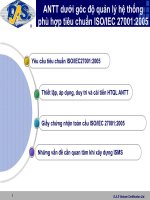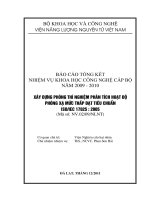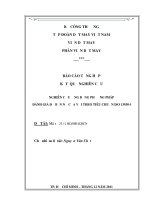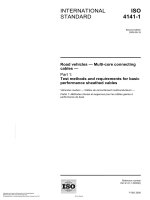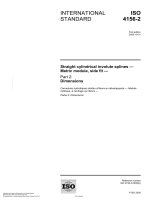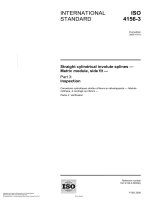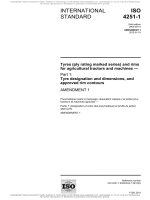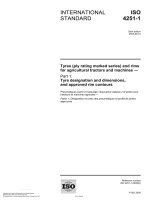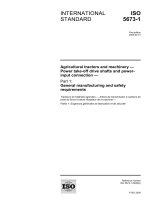Tiêu chuẩn iso 04156 1 2005
Bạn đang xem bản rút gọn của tài liệu. Xem và tải ngay bản đầy đủ của tài liệu tại đây (3.4 MB, 66 trang )
INTERNATIONAL
STANDARD
ISO
4156-1
First edition
2005-10-01
Straight cylindrical involute splines —
Metric module, side fit —
Part 1:
Generalities
Cannelures cylindriques droites à flancs en développante — Module
métrique, à centrage sur flancs —
Partie 1: Généralités
--`,,```,,,,````-`-`,,`,,`,`,,`---
Reference number
ISO 4156-1:2005(E)
Copyright International Organization for Standardization
Reproduced by IHS under license with ISO
No reproduction or networking permitted without license from IHS
© ISO 2005
Not for Resale
ISO 4156-1:2005(E)
PDF disclaimer
This PDF file may contain embedded typefaces. In accordance with Adobe's licensing policy, this file may be printed or viewed but
shall not be edited unless the typefaces which are embedded are licensed to and installed on the computer performing the editing. In
downloading this file, parties accept therein the responsibility of not infringing Adobe's licensing policy. The ISO Central Secretariat
accepts no liability in this area.
Adobe is a trademark of Adobe Systems Incorporated.
Details of the software products used to create this PDF file can be found in the General Info relative to the file; the PDF-creation
parameters were optimized for printing. Every care has been taken to ensure that the file is suitable for use by ISO member bodies. In
the unlikely event that a problem relating to it is found, please inform the Central Secretariat at the address given below.
© ISO 2005
All rights reserved. Unless otherwise specified, no part of this publication may be reproduced or utilized in any form or by any means,
electronic or mechanical, including photocopying and microfilm, without permission in writing from either ISO at the address below or
ISO's member body in the country of the requester.
ISO copyright office
Case postale 56 • CH-1211 Geneva 20
Tel. + 41 22 749 01 11
Fax + 41 22 749 09 47
Web www.iso.org
Published in Switzerland
ii
--`,,```,,,,````-`-`,,`,,`,`,,`---
Copyright International Organization for Standardization
Reproduced by IHS under license with ISO
No reproduction or networking permitted without license from IHS
© ISO 2005 – All rights reserved
Not for Resale
ISO 4156-1:2005(E)
Contents
Page
Foreword............................................................................................................................................................ iv
Introduction ........................................................................................................................................................ v
1
Scope ......................................................................................................................................................1
2
Normative references ............................................................................................................................1
3
Terms and definitions ...........................................................................................................................1
4
4.1
4.2
4.3
Symbols, subscripts and abbreviated terms ......................................................................................7
General symbols ....................................................................................................................................7
Subscripts ..............................................................................................................................................9
Formulae for dimensions and tolerances for all fit classes..............................................................9
5
Concept of side fit splines ..................................................................................................................12
6
Effective fit concept.............................................................................................................................14
7
Basic rack profiles for spline..............................................................................................................22
8
Spline fit classes..................................................................................................................................24
9
9.1
9.2
9.3
9.4
9.5
9.6
9.7
9.8
Space width and tooth thickness tolerances....................................................................................26
Total tolerance T + λ ............................................................................................................................26
Deviation allowance, λ ........................................................................................................................27
Total pitch deviation, Fp ......................................................................................................................27
Total profile deviation, Fα ...................................................................................................................28
Total helix deviation, Fβ ......................................................................................................................29
Machining tolerance, T ........................................................................................................................29
Effective clearance tolerance, Tv........................................................................................................30
Use of effective and actual dimensions for space width and tooth thickness .............................30
10
10.1
10.2
Minor and major diameters.................................................................................................................31
Tolerances ............................................................................................................................................31
Adjustment to minor diameters (Die), form diameters (DFe) and major diameters (Dee) of
external splines....................................................................................................................................32
11
11.1
11.2
11.3
Manufacturing and design considerations .......................................................................................32
Radii ......................................................................................................................................................32
Profile shifts .........................................................................................................................................32
Eccentricity and misalignment...........................................................................................................33
12
12.1
12.2
12.3
12.4
Spline data............................................................................................................................................34
Basic dimensions ................................................................................................................................34
Combination of types ..........................................................................................................................34
Designation ..........................................................................................................................................34
Drawing data ........................................................................................................................................35
Annex A (informative) Drawing data example calculations ..........................................................................40
Bibliography ......................................................................................................................................................59
iii
© ISO 2005 – All rights reserved
--`,,```,,,,````-`-`,,`,,`,`,,`---
Copyright International Organization for Standardization
Reproduced by IHS under license with ISO
No reproduction or networking permitted without license from IHS
Not for Resale
ISO 4156-1:2005(E)
Foreword
ISO (the International Organization for Standardization) is a worldwide federation of national standards bodies
(ISO member bodies). The work of preparing International Standards is normally carried out through ISO
technical committees. Each member body interested in a subject for which a technical committee has been
established has the right to be represented on that committee. International organizations, governmental and
non-governmental, in liaison with ISO, also take part in the work. ISO collaborates closely with the
International Electrotechnical Commission (IEC) on all matters of electrotechnical standardization.
International Standards are drafted in accordance with the rules given in the ISO/IEC Directives, Part 2.
Attention is drawn to the possibility that some of the elements of this document may be the subject of patent
rights. ISO shall not be held responsible for identifying any or all such patent rights.
ISO 4156-1 was prepared by Technical Committee ISO/TC 14, Shafts for machinery and accessories.
This first edition of ISO 4156-1, together with ISO 4156-2 and ISO 4156-3, cancels and replaces
ISO 4156:1981 and ISO 4156:1981/Amd 1:1992, of which it constitutes a technical revision. The values and
tables are the same as in ISO 4156:1981; however, some explanations and definitions have been clarified.
ISO 4156 consists of the following parts, under the general title Straight cylindrical involute splines — Metric
module, side fit:
Part 1: Generalities
Part 2: Dimensions
Part 3: Inspection
iv
Copyright International Organization for Standardization
Reproduced by IHS under license with ISO
No reproduction or networking permitted without license from IHS
© ISO 2005 – All rights reserved
Not for Resale
--`,,```,,,,````-`-`,,`,,`,`,,`---
The main task of technical committees is to prepare International Standards. Draft International Standards
adopted by the technical committees are circulated to the member bodies for voting. Publication as an
International Standard requires approval by at least 75 % of the member bodies casting a vote.
ISO 4156-1:2005(E)
Introduction
ISO 4156 provides the data and indications necessary for the design, manufacture and inspection of straight
(non-helical) side-fitting cylindrical involute splines.
Straight cylindrical involute splines manufactured in accordance with ISO 4156 are used for clearance, sliding
and interference connections of shafts and hubs. They contain all the necessary characteristics for the
assembly, transmission of torque, and economic production.
The nominal pressure angles are 30°, 37,5° and 45°. For electronic data processing purposes, the form of
expression 37,5° has been adopted instead of 37°30’. ISO 4156 establishes a specification based on the
following modules:
for pressure angles of 30° and 37,5° the module increments are
0,5; 0,75; 1; 1,25; 1,5; 1,75; 2; 2,5; 3; 4; 5; 6; 8; 10
for pressure angle of 45° the module increments are
0,25; 0,5; 0,75; 1; 1,25; 1,5; 1,75; 2; 2,5
--`,,```,,,,````-`-`,,`,,`,`,,`---
v
© ISO 2005 – All rights reserved
Copyright International Organization for Standardization
Reproduced by IHS under license with ISO
No reproduction or networking permitted without license from IHS
Not for Resale
--`,,```,,,,````-`-`,,`,,`,`,,`---
Copyright International Organization for Standardization
Reproduced by IHS under license with ISO
No reproduction or networking permitted without license from IHS
Not for Resale
INTERNATIONAL STANDARD
ISO 4156-1:2005(E)
Straight cylindrical involute splines — Metric module, side fit —
1
--`,,```,,,,````-`-`,,`,,`,`,,`---
Part 1:
Generalities
Scope
This part of ISO 4156 provides the data and indications necessary for the design and manufacture of straight
(non-helical) side-fitting cylindrical involute splines.
Limiting dimensions, tolerances, manufacturing errors and their effects on the fit between connecting coaxial
spline elements are defined in the equations and given in the tables. Unless otherwise specified, linear
dimensions are expressed in millimetres and angular dimensions in degrees.
2
Normative references
The following referenced documents are indispensable for the application of this document. For dated
references, only the edition cited applies. For undated references, the latest edition of the referenced
document (including any amendments) applies.
ISO 286-1, ISO system of limits and fits — Part 1: Bases of tolerances, deviations and fits
ISO 1101, Geometrical Product Specifications (GPS) — Geometrical tolerancing — Tolerances of form,
orientation, location and run-out
ISO 4156-2, Straight cylindrical involute splines — Metric module, side fit — Part 2: Dimensions
ISO 4156-3:2005, Straight cylindrical involute splines — Metric module, side fit — Part 3: Inspection
3
Terms and definitions
For the purposes of this document, the following terms and definitions apply.
3.1
spline joint
connecting, coaxial elements that transmit torque through the simultaneous engagement of equally spaced
teeth situated around the periphery of a cylindrical external member with similar spaced mating spaces
situated around the inner surface of the related cylindrical internal member
3.2
involute spline
member of spline joint having teeth or spaces that have involute flank profiles
3.3
internal spline
spline formed on the inner surface of a cylinder
1
© ISO 2005 – All rights reserved
Copyright International Organization for Standardization
Reproduced by IHS under license with ISO
No reproduction or networking permitted without license from IHS
Not for Resale
ISO 4156-1:2005(E)
3.4
external spline
spline formed on the outer surface of a cylinder
3.5
fillet
concave surface of the tooth or space connecting the involute flank and the root circle.
NOTE
This curved surface as generated varies and cannot be properly specified by a radius of any given value.
3.6
fillet root spline
spline having a tooth or space profile in which the opposing involute flanks are connected to the root circle (Dei
or Die diameter) by a single fillet.
3.7
flat root spline
spline having a tooth or space profile in which each of the opposing involute flanks are connected to the root
circle (Dei or Die diameter) by a fillet
3.8
module
m
ratio of the circular pitch, expressed in millimetres, to the number π (or the ratio of the pitch diameter
expressed in millimetres, to the number of teeth)
3.9
pitch circle
reference circle from which all normal spline dimensions are derived, and the circle on which the specified
pressure angle has its nominal value
3.10
pitch diameter
D
diameter of the pitch circle, in millimetres, equal to the number of teeth multiplied by the module
3.11
pitch point
intersection of the spline tooth profile with the pitch circle
--`,,```,,,,````-`-`,,`,,`,`,,`---
3.12
circular pitch
p
length of arc of the pitch circle between two consecutive pitch points of left- (or right-) hand flanks, which has a
value of the number π multiplied by the module
3.13
pressure angle
α
acute angle between a radial line passing through any point on a tooth flank and the tangent plane to the flank
at that point
3.14
standard pressure angle
αD
pressure angle at the specified pitch point
2
Copyright International Organization for Standardization
Reproduced by IHS under license with ISO
No reproduction or networking permitted without license from IHS
© ISO 2005 – All rights reserved
Not for Resale
ISO 4156-1:2005(E)
3.15
base circle
circle from which Involute spline tooth profiles are generated
3.16
base diameter
Db
diameter of the base circle
3.17
base pitch
pb
arc length of the base circle between two consecutive corresponding flanks
3.18
major circle
outermost (largest) circle of the external or internal spline
3.19
major diameter
Dee, Dei
diameter of the major circle
3.20
minor circle
innermost (smallest) circle of the external or internal spline
3.21
minor diameter, Die, Dii
diameter of the minor circle
3.22
form circle
circle used to define the depth of involute profile control
NOTE
In the case of an external spline it is located near and above the minor diameter, and on an internal spline
near and below the major diameter
3.23
form diameter
DFe, DFi
diameter of the form circle
3.24
depth of engagement
radial distance from the minor circle of the internal spline to the major circle of the external spline, minus
corner clearance and/or chamfer depth
3.25
basic (circular) space width or tooth thickness at the pitch diameter
E or S
for 30°, 37,5° and 45° pressure angle splines, half the circular pitch.
3.26
actual space width
practically measured circular space width, on the pitch circle, of any single space width within the limit values
Emax and Emin
--`,,```,,,,````-`-`,,`,,`,`,,`---
3
© ISO 2005 – All rights reserved
Copyright International Organization for Standardization
Reproduced by IHS under license with ISO
No reproduction or networking permitted without license from IHS
Not for Resale
ISO 4156-1:2005(E)
3.27
effective space width
Ev
space width where an imaginary perfect external spline would fit without clearance or interference, given by
the size of the tooth thickness of this external spline, considering engagement of the entire axial length of the
splined assembly
NOTE
The minimum effective space width (Ev min, always equal to E) of the internal spline is always basic, as shown
in Table 3.
3.28
actual tooth thickness
practically measured circular tooth thickness, on the pitch circle, of any single tooth within the limit values Smax
and Smin
3.29
effective tooth thickness
Sv
tooth thickness where an imaginary perfect internal spline would fit without clearance or interference, given by
the size of the space width of this internal spline, considering engagement of the entire axial length of the
splined assembly
3.30
effective clearance
cv
〈looseness or interference〉 effective space width of the internal spline minus the effective tooth thickness of
the external spline
NOTE
For looseness, cv is positive; for interference, cv is negative.
3.31
theoretical clearance
c
〈looseness or interference〉 actual space width of the internal spline minus the actual tooth thickness of the
external spline
NOTE
It does not define the effective fit between internal and external spline, because of the effect of deviations.
3.32
form clearance
cF
radial clearance between the form diameter of the internal spline and the major diameter of the external
spline, or between the minor diameter of the internal spline and the form diameter of the external spline
NOTE
It allows eccentricity of their respective pitch circles.
3.33
total pitch deviation
Fp
absolute value of the difference between the greatest positive and negative deviations from the theoretical
spacing
3.34
total profile deviation
Fα
absolute value of the difference between the greatest positive and negative deviations from the theoretical
tooth profile, measured normal to the flanks
4
Copyright International Organization for Standardization
Reproduced by IHS under license with ISO
No reproduction or networking permitted without license from IHS
© ISO 2005 – All rights reserved
--`,,```,,,,````-`-`,,`,,`,`,,`---
Not for Resale
ISO 4156-1:2005(E)
3.35
total helix deviation
Fβ
absolute value of the difference between the two extreme deviations from the theoretical direction parallel to
the reference axis
NOTE
This includes parallelism and alignment deviations, see Figure 1.
a)
Helix deviation
b) Parallelism deviation
c)
a
Alignment deviation
Reference axis.
b
Centreline of teeth.
c
Effective spline axis.
Figure 1 — Helix deviations
3.36
parallelism deviation
deviation of parallelism of a single spline tooth to any other single spline tooth
See Figure 1 b).
3.37
alignment deviation
deviation of the effective spline axis with respect to the reference axis
See Figure 1 c).
3.38
out-of-roundness
deviation of the spline from a true circular configuration
3.39
effective deviation
accumulated effect of the spline deviations on the fit with the mating part
--`,,```,,,,````-`-`,,`,,`,`,,`---
5
© ISO 2005 – All rights reserved
Copyright International Organization for Standardization
Reproduced by IHS under license with ISO
No reproduction or networking permitted without license from IHS
Not for Resale
ISO 4156-1:2005(E)
3.40
deviation allowance
λ
permissible deviation between minimum actual and minimum effective space width or maximum effective and
maximum actual tooth thickness
3.41
machining tolerance
T
permissible deviation between maximum actual and minimum actual space width or tooth thickness
3.42
effective clearance tolerance
Tv
permissible deviation between maximum effective and minimum effective space width or tooth thickness
3.43
total tolerance
T+λ
machining tolerance plus the deviation allowance
3.43.1
total tolerance
〈internal spline〉 difference between the minimum effective space width and the maximum actual space width
3.43.2
total tolerance
〈external spline〉 difference between the maximum effective tooth thickness and the minimum actual tooth
thickness
3.44
basic dimension
numerical value to describe the theoretically exact size, shape or location of a feature
NOTE
It is the basis from which permissible deviations are established by tolerances.
3.45
auxiliary dimension
dimension, without tolerance, given for information purposes only, for the determination of the useful
production and control dimensions.
--`,,```,,,,````-`-`,,`,,`,`,,`---
6
Copyright International Organization for Standardization
Reproduced by IHS under license with ISO
No reproduction or networking permitted without license from IHS
© ISO 2005 – All rights reserved
Not for Resale
ISO 4156-1:2005(E)
4
Symbols, subscripts and abbreviated terms
4.1
General symbols
The general symbols used to designate the various spline terms and dimensions are given below.
D
Pitch diameter
mm
DFe
Form diameter, external spline
mm
DFe max
Maximum form diameter, external spline
mm
DFi
Form diameter, internal spline
mm
DFi min
Minimum form diameter, internal spline
mm
DRe
Diameter of measuring ball or pin for external spline
mm
DRi
Diameter of measuring ball or pin for internal spline
mm
Db
Base diameter
mm
Dee
Major diameter, external spline
mm
Dee max
Maximum major diameter, external spline
mm
Dee min
Minimum major diameter, external spline
mm
Dei
Major diameter, internal spline
mm
Dei max
Maximum major diameter, internal spline
mm
Dei min
Minimum major diameter, internal spline
mm
Die
Minor diameter, external spline
mm
Die max
Maximum minor diameter, external spline
mm
Die min
Minimum minor diameter, external spline
mm
Dii
Minor diameter, internal spline
mm
Dii max
Maximum minor diameter, internal spline
mm
Dii min
Minimum minor diameter, internal spline
mm
E
Basic space width, circular
mm
Emax
Maximum actual space width
mm
Emin
Minimum actual space width
mm
Ev
Effective space width, circular
mm
Ev max
Maximum effective space width
mm
Ev min
Minimum effective space width
mm
Fp
Total cumulative pitch deviation
µm
Fα
Total profile deviation
µm
Fβ
Total helix deviation
µm
Ke
Approximation factor for external spline
—
Ki
Approximation factor for internal spline
—
MRe
Measurement over two balls or pins, external splines
mm
MRi
Measurement between two balls or pins, internal
mm
S
Basic tooth thickness, circular
mm
7
--`,,```,,,,````-`-`,,`,,`,`,,`---
© ISO 2005 – All rights reserved
Copyright International Organization for Standardization
Reproduced by IHS under license with ISO
No reproduction or networking permitted without license from IHS
Not for Resale
ISO 4156-1:2005(E)
Maximum actual tooth thickness
mm
Smin
Minimum actual tooth thickness
mm
Sv
Effective tooth thickness, circular
mm
Sv max
Maximum effective tooth thickness
mm
Sv min
Minimum effective tooth thickness
mm
T
Machining tolerance
µm
Tv
Effective clearance tolerance
µm
W
Measurement over k teeth, external spline
mm
b
Spline length
mm
cF
Form clearance
mm
cv
Effective clearance (looseness or interference)
µm
cv max
Maximum effective clearance
µm
cv min
Minimum effective clearance
µm
dce
Ball or pin contact diameter, external spline
mm
dci
Ball or pin contact diameter, internal spline
mm
esv
Fundamental deviation, external
µm
Form tooth height
mm
inv α
Involute α (= tanα − π ⋅ α /180° )
—
k
Number of measured teeth
—
m
Module
mm
p
Circular pitch
mm
pb
Base pitch
mm
z
Number of teeth
—
α
Pressure angle
°
αFe
Pressure angle at form diameter, external spline
°
αFi
Pressure angle at form diameter, internal spline
°
αce
Pressure angle at ball or pin diameter, external spline
°
αci
Pressure angle at ball or pin diameter, internal spline
°
αD
Standard pressure angle at pitch diameter
°
αe
Pressure angle at ball or pin centre, external spline
°
αi
Pressure angle at ball or pin centre, internal spline
°
λ
Deviation allowance
µm
ρFa
Fillet radius of the basic rack, external spline
mm
ρFi
Fillet radius of the basic rack, internal spline
mm
k; js; h; f; e; d
Fundamental deviation of the external spline
µm
hs
--`,,```,,,,````-`-`,,`,,`,`,,`---
Smax
8
Copyright International Organization for Standardization
Reproduced by IHS under license with ISO
No reproduction or networking permitted without license from IHS
© ISO 2005 – All rights reserved
Not for Resale
ISO 4156-1:2005(E)
4.2
Subscripts
The following subscripts are used as part of the above general symbols to designate relative conditions or
locations:
i
minor or internal (in the last case in the last position)
e
major or external (in the last case in the last position)
b
at the base
c
at contact point
d
tolerance based on pitch diameter (D)
E
tolerance based on space width (E) or tooth thickness (S)
F
pertaining to form diameter
v
effective
R
pertaining to gauges
D
standard
NOTE
In electronic data processing (EDP), it is not always possible to present symbols in their theoretically correct
form because of limitations of connected printing equipment. For this reason, some alternative symbols for EDP usage are
given in Table 1 (for example, the symbol for Db for base diameter may be printed as DB).
4.3
Formulae for dimensions and tolerances for all fit classes
The formulae for dimensions and tolerances for all fit classes are given in Table 1.
--`,,```,,,,````-`-`,,`,,`,`,,`---
9
© ISO 2005 – All rights reserved
Copyright International Organization for Standardization
Reproduced by IHS under license with ISO
No reproduction or networking permitted without license from IHS
Not for Resale
ISO 4156-1:2005(E)
Table 1 — Formulae for dimensions and tolerances for all fit classes
Term
EDP
representation
Symbol
Formula
Pitch diameter
D
m⋅ z
D
Base diameter
Db
m ⋅ z ⋅ cosα D
DB
Circular pitch
p
m⋅π
P
Base pitch
pb
m ⋅ π ⋅ cos α D
PB
Fundamental deviation, external
esv
Resulting from fundamental deviation
k, js, h, f, e and d
ESV
30°, flat root
Dei min
m ⋅ ( z + 1,5)
DEIMIN
30°, fillet root
Dei min
m ⋅ (z + 1,8)
DEIMIN
37,5°, fillet root
Dei min
m ⋅ (z + 1,4)
DEIMIN
45°, fillet root
Dei min
m ⋅ (z + 1,2)
DEIMIN
Dei max
D ei min + (T + λ ) / tan α D (see Note 1)
DEIMAX
30° flat root and fillet root
DFi min
m ⋅ ( z + 1) + 2 ⋅ c F
DFIMIN
37,5° fillet root
DFi min
m ⋅ ( z + 0,9) + 2 ⋅ c F
DFIMIN
45° fillet root
DFi min
m ⋅ ( z + 0,8) + 2 ⋅ c F
DFIMIN
Dii min
DFe max + 2 ⋅ c F (see Note 2)
DIIMIN
m u 0,75
Dii max
D ii min + IT 10
DIIMAX
0,75 < m < 2
Dii max
D ii min + IT 11
DIIMAX
mW2
Dii max
D ii min + IT 12
DIIMAX
Maximum major diameter, internal
Minimum form diameter, internal:
Minimum minor diameter, internal
Maximum minor diameter, internal:
E
0,5 ⋅ π ⋅ m
E
Ev min
0,5 ⋅ π ⋅ m
EVMIN
class 4
Emax
E v min + (T + λ ) (see Note 3)
EMAX
class 5
Emax
E v min + (T + λ ) (see Note 3)
EMAX
class 6
Emax
E v min + (T + λ ) (see Note 3)
EMAX
class 7
Emax
E v min + (T + λ ) (see Note 3)
EMAX
Emin
E v min + λ
EMIN
Ev max
E v min + T v
EVMAX
30°, flat root and fillet root
Dee max
m ⋅ ( z + 1) + es v /tanα D (see Note 4)
DEEMAX
37,5°, fillet root
Dee max
m ⋅ ( z + 0,9) + es v /tanα D (see Note 4)
DEEMAX
45°, fillet root
Dee max
m ⋅ ( z + 0,8) + es v /tanα D (see Note 4)
DEEMAX
m u 0,75
Dee min
D eemax − IT 10
DEEMIN
0,75 < m < 2
Dee min
D ee max − IT 11
DEEMIN
mW2
Dee min
D ee max − IT 12
DEEMIN
Basic space width
Minimum effective space width
Maximum actual space width:
Minimum actual space width
Maximum effective space width
Maximum major diameter, external:
Minimum major diameter, external:
10
Copyright International Organization for Standardization
Reproduced by IHS under license with ISO
No reproduction or networking permitted without license from IHS
© ISO 2005 – All rights reserved
Not for Resale
--`,,```,,,,````-`-`,,`,,`,`,,`---
Minimum major diameter, internal:
ISO 4156-1:2005(E)
--`,,```,,,,````-`-`,,`,,`,`,,`---
Table 1 (continued)
Term
Maximum form diameter (see Note 5)
Symbol
DFe max
EDP
representation
Formula
0,5 × es v
hs −
tanα D
2
2 × ( 0,5D b ) + 0,5D × sinα D −
sinα D
2
DFEMAX
Maximum minor diameter, external:
30°, flat root
Die max
m ⋅ ( z − 1,5) + es v /tanα D
DIEMAX
30°, fillet root
Die max
m ⋅ ( z − 1,8) + es v /tanα D
DIEMAX
37,5°, fillet root
Die max
m ⋅ ( z − 1,4) + es v /tanα D
DIEMAX
45°, fillet root
Die max
m ⋅ ( z − 1,2) + es v /tanα D
DIEMAX
Die min
D ie max − (T + λ )/tanα D (see Note 1)
DIEMIN
S
0,5 ⋅ π ⋅ m
S
Sv max
S + es v
SVMAX
class 4
Smin
S v max − (T + λ ) (see Note 3)
SMIN
class 5
Smin
S v max − (T + λ ) (see Note 3)
SMIN
class 6
Smin
S v max − (T + λ ) (see Note 3)
SMIN
class 7
Smin
S v max − (T + λ ) (see Note 3)
SMIN
Maximum actual tooth thickness
Smax
S v max − λ
SMAX
Minimum effective tooth thickness
Sv min
S v max − T v
SVMIN
Total tolerance, space width or tooth
thickness
(T + λ )
(see Note 6)
TLAM
Maximum effective clearance
cv max
E v max − S v min
CVMAX
Minimum effective clearance
cv min
E v min − S v max
CVMIN
Form clearance
cF
see Note 5
CF
Form tooth height
hs
see Note 5
HS
Ball or pin diameter, internal spline
DRi
see Note 7
DRI
Ball or pin diameter, external spline
DRe
see Note 7
DRE
Measurement between balls or pins
Mri
see Note 7
MRI
Measurement over balls or pins
Mre
see Note 7
MRE
Change factor, internal
Ki
see Note 7
KI
Change factor, external
Ke
see Note 7
KE
Minimum minor diameter, external
Basic tooth thickness
Maximum effective tooth thickness
Minimum actual tooth thickness:
NOTE 1
NOTE 2
(T + λ) for class 7 — see 9.1.
For all classes of fit, always take the DFe max value corresponding to the H/h fit.
NOTE 3
NOTE 4
See Clause 8 and ISO 4156-2.
Take esv = 0 for fundamental deviation js and k.
NOTE 5
For hs, see Figure 15 et Table 2.
NOTE 6
NOTE 7
See 9.1.
See ISO 4156-3 concerning the choice of balls or pins.
11
© ISO 2005 – All rights reserved
Copyright International Organization for Standardization
Reproduced by IHS under license with ISO
No reproduction or networking permitted without license from IHS
Not for Resale
ISO 4156-1:2005(E)
5
Concept of side fit splines
This part of ISO 4156 defines side fit involute splines with pressure angles of 30°, 37,5° and 45°. The
transmission of torque is achieved by contact of the tooth flanks only. This is possible in the clockwise or
anticlockwise direction of rotation (see Figure 2). The opposite tooth flanks, major and minor diameters shall
have clearance.
Clockwise rotation
Anticlockwise rotation
Figure 2 — Side fit tooth flank contact
--`,,```,,,,````-`-`,,`,,`,`,,`---
The nature of the involute profile divides the torque into two directions resulting in a centring force (see
Figure 3). This centring force enables side fit involute splines to be centralized by the tooth flanks.
a
Centring force.
b
Rotation force.
c
Torque.
Figure 3 — Centring force
12
Copyright International Organization for Standardization
Reproduced by IHS under license with ISO
No reproduction or networking permitted without license from IHS
© ISO 2005 – All rights reserved
Not for Resale
ISO 4156-1:2005(E)
The sizes of space width and tooth thickness (see Figure 4) are defined as the length of the arc at the
theoretical pitch circle diameter.
Figure 4 — Space width and tooth thickness
The major and minor diameters (see Figure 5) always have clearance and do not contact each other.
--`,,```,,,,````-`-`,,`,,`,`,,`---
Figure 5 — Diameters
13
© ISO 2005 – All rights reserved
Copyright International Organization for Standardization
Reproduced by IHS under license with ISO
No reproduction or networking permitted without license from IHS
Not for Resale
ISO 4156-1:2005(E)
6
Effective fit concept
To be able to machine the spaces of internal splines and the teeth of external splines, a machining tolerance
commonly referred to as the actual machining tolerance is necessary. Four classes of machining tolerance
(classes 4, 5, 6 and 7) are provided for the different needs of industrial use. The machining tolerance, T (see
Figure 6), is applied to the space width of internal splines and to the tooth thickness of external splines.
The upper machining tolerance limit is referred to as maximum actual and the lower one is referred to as
minimum actual.
The form deviations consist of three types: profile deviation, index deviation and helix deviation. The positive
material elements of these deviations result in a reduction of effective space width of an internal spline, or an
increase in the effective tooth thickness of an external spline, and hence a reduction in the effective clearance.
This effect can only be detected by the use of an imaginary perfect mating spline that fits without looseness or
interference.
a)
Internal spline
b) External spline
a
Largest space width.
d
Minimum actual tolerance.
b
Smallest space width.
e
Largest tooth thickness.
Maximum actual tolerance.
f
Smallest tooth thickness.
c
Figure 6 — Machining tolerance, T
14
Copyright International Organization for Standardization
Reproduced by IHS under license with ISO
No reproduction or networking permitted without license from IHS
© ISO 2005 – All rights reserved
Not for Resale
--`,,```,,,,````-`-`,,`,,`,`,,`---
Similar to cylindrical fits between hubs and shafts, form deviations of the geometry (see Figure 7) affect the
maximum material condition and hence the fit. The form deviation is the deviation compared to the perfect
cylinder. The form deviations of splines are much more complex and occur on each flank of every space or
tooth. These form deviations have an accumulative effect which is referred to as effective deviation.
--`,,```,,,,````-`-`,,`,,`,`,,`---
ISO 4156-1:2005(E)
a
Form deviation.
Figure 7 — Form deviations
15
© ISO 2005 – All rights reserved
Copyright International Organization for Standardization
Reproduced by IHS under license with ISO
No reproduction or networking permitted without license from IHS
Not for Resale
ISO 4156-1:2005(E)
The positive material elements of profile deviation (see Figure 8) will result in a smaller space or a larger tooth
thickness which has an effect on the fit with a mating part.
a
Internal spline.
b
External spline.
c
Space width, actual.
d
Tooth thickness, actual.
e
Space width, effective.
f
Tooth thickness, effective.
g
Mating part.
--`,,```,,,,````-`-`,,`,,`,`,,`---
Figure 8 — Profile deviation
16
Copyright International Organization for Standardization
Reproduced by IHS under license with ISO
No reproduction or networking permitted without license from IHS
© ISO 2005 – All rights reserved
Not for Resale
ISO 4156-1:2005(E)
The positive material elements of pitch deviation (see Figure 9) will also result in a smaller space width or a
larger tooth thickness which again affects the fit with a mating part.
--`,,```,,,,````-`-`,,`,,`,`,,`---
a
Internal spline.
b
External spline.
c
Space width, actual.
d
Tooth thickness, actual.
e
Space width, effective.
f
Tooth thickness, effective.
g
Mating part.
Figure 9 — Pitch deviation
17
© ISO 2005 – All rights reserved
Copyright International Organization for Standardization
Reproduced by IHS under license with ISO
No reproduction or networking permitted without license from IHS
Not for Resale
ISO 4156-1:2005(E)
--`,,```,,,,````-`-`,,`,,`,`,,`---
The positive material elements of helix deviation (see Figure 10) will also result in a smaller space width or a
larger tooth thickness which again affects the fit with a mating part.
a
Internal spline.
b
External spline.
c
Space width, actual.
d
Tooth thickness, actual.
e
Space width, effective.
f
Tooth thickness, effective.
g
Mating part.
Figure 10 — Helix deviation
The accumulated form deviations (see Figure 11) of each flank result in an effective size of space width or
tooth thickness.
18
Copyright International Organization for Standardization
Reproduced by IHS under license with ISO
No reproduction or networking permitted without license from IHS
© ISO 2005 – All rights reserved
Not for Resale
ISO 4156-1:2005(E)
--`,,```,,,,````-`-`,,`,,`,`,,`---
a
Profile deviation.
b
Pitch deviation.
c
Helix deviation.
d
Tooth.
e
Maximum at Tooth 1.
f
Maximum at Tooth 4.
g
Maximum at Tooth 6.
h
Maximum at Tooth 5.
i
Accumulation = effective deviation λ.
j
Theoretical maximum.
Figure 11 — Influence of form deviations
19
© ISO 2005 – All rights reserved
Copyright International Organization for Standardization
Reproduced by IHS under license with ISO
No reproduction or networking permitted without license from IHS
Not for Resale
